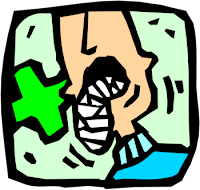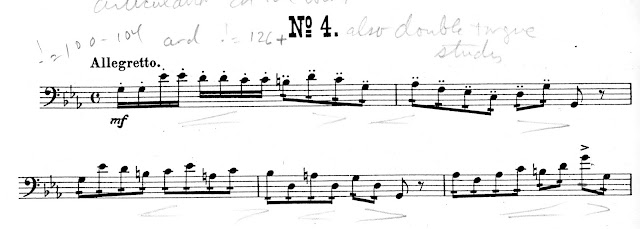The concert is over. My bassoon is
silent now. I swab and put it away for
the night. Tomorrow I will continue my search for resonance.
Every night my sound disappears. I must
search it out every time I put a reed on my bocal and begin to play. Will I find the sound I’m looking for?
“Mastery
of the bassoon is transitory and must be renewed daily.” – Norman Herzberg
The bassoon makes no sound on its own.
It is my responsibility to coax the sound I imagine into life.
In this post, I'll show you some pictures of my sound! These are called spectrographs. They are a visual realization in the form of a graph of the different parts of an individual pitch.
I recorded samples of various pitches after finishing the recording session for "Curly Maple Rag" and "Lancashire Rag" for Bryan Dykstra's "Neo Ragtime" CD.
Since I'll be showing you several spectrographs, a short introduction is in order.
The horizontal axis of the graph shows the number of Hertz (or cycles per second) for every part of the sound.
The vertical axis shows the relative amplitude of the sound throughout its spectrum as measured in decibels. Roughly speaking, this axis shows the strengths and weaknesses in a given pitch.
Resonance peaks or harmonics in the sound are represented by the peaks of the red "mountain range" in the graph.
Why is knowing about the strength of the harmonics in an individual pitch important?
Having at least a passing understanding of this is important because the timbre, focus, projection of your sound is directly related to the strength or weakness of the harmonic series for each pitch you play.
In this post I'm going to show you what the sound spectrum of a pitch played on a good reed looks like versus that played on a bad reed, loud dynamic, soft dynamic, sharp pitch versus in tune, etc. I'm sure you'll find this interesting.
A couple of disclaimers before I start.
1. I don't know how easy the graphs will be to read. I'll try to crop, enlarge, label for easier reading.
2. I'm wading into deep waters with this subject and feel a little out of my league. If I'm throwing around terms that any of you know more about than I do, please comment and help correct/amend my arguments!
Seeing My Sound
Words used by one person to describe
sound may not mean the same thing to another.
While it is important to focus one’s thoughts when describing sound, I
wondered if there was a way to present qualities in bassoon sound objectively.
The answer, as it turns out, is yes and
no.
In 1962, Paul Lehman recorded
bassoonists from orchestras in Detroit, Cleveland, Philadelphia, Boston and
Berlin in an attempt to discover what physical qualities characterize bassoon
sound. (The Structure of the Tone of theBassoon, Paul Robert Lehman, University of Michigan, 1962). His study recorded
individual notes covering the full range of the bassoon at soft, medium and
loud dynamics for all 11 bassoonists. The charts in the study show the strength
of each partial for each note recorded. The results make fascinating reading.
Below are some of the conclusions Lehman
drew from the data in his study.
-
There is a strong formant in the tone of the bassoon extending approximately from 440-494 cycles per second.
- There is also a weaker formant extending approximately 1220 to 1280 cycles.
- The strongest partial in the spectrum is normally the one that lies closest to the center of the first formant.
- The fundamental, except when it lies in the formant, tends to be relatively weak.
- Although there are significant variations in the pattern from one register to another and from one dynamic level to another, the envelope of the bassoon spectrum tends to rise steadily from the fundamental to the peak of the first formant and then descend slowly in a strongly skewed manner.
- In general, fewer partials are present in a pianissimo tone than in the same tone played fortissimo. Also, fewer partials are present in a high tone than in a low tone of the same dynamic level.
- There
is a marked drop in the relative energy of the partials above the first formant
in the pianissimo tones as compared with the fortissimo tones. However, the
partials below the first formant including the fundamental, tend to be somewhat
stronger, relatively, at the pianissimo level.
In the summer of 2009 I recorded some
music at SoundEngineers studio in Bentleyville, OH. After one of the sessions, the engineer,
Bruce Gigax, spent a few minutes with me recording individual notes in
isolation.
I started with a very resonant note on
the bassoon, c (Using Helmholtz’ system the C one octave below middle C on the
piano).
In these graphs, the high points are
resonance peaks, corresponding with the frequency of each partial in the sound.
Areas of solid color below the peaks can be described as “noise” in the sound that does not contribute directly
to the recognition of the pitch in question.
As noted by Lehman, the fundamental is
relatively weak with the second and third partials progressively stronger,
rising to the peak of the fourth partial in the range of the first formant.
Compare this spectrum with my next
sample, the same c played on a bad reed.
This was a very dull and unresponsive reed. In this spectrum, the
resonance peaks are particularly weak above the formant, whereas in the first
spectrum they remain strong well into the 3000Hz range.
Here is a graph of both spectra. The good reed is graphed in green, the bad in purple

Good reed = green
Bad reed = purple
You can see that after the first few harmonics, the bad reed loses resonance quickly with the peaks much lower than the good reed. The good reed also keeps a much wider variance in peaks and valleys throughout. Perhaps this accounts for its clarity and focus?
Here is a graph of both spectra. The good reed is graphed in green, the bad in purple

Good reed = green
Bad reed = purple
You can see that after the first few harmonics, the bad reed loses resonance quickly with the peaks much lower than the good reed. The good reed also keeps a much wider variance in peaks and valleys throughout. Perhaps this accounts for its clarity and focus?
In the “pp” c, the resonance peaks and
valleys are less stark than in the first c spectrum. This is especially true
above the formant where the peaks appear as though they have been planed off.
Below I plotted the spectrum for the c played at three different dynamics -- "pp", "mf" and "ff"
Below I plotted the spectrum for the c played at three different dynamics -- "pp", "mf" and "ff"
"pp" c = green
"ff" c = red
"mf" c = purple
The big differences again come with the higher partials with the "pp" reed "flat lining" and the others maintaining more contrast in peaks and valleys. Perhaps the fortissimo peaks a little higher in places than the mf.
Next I sampled the same note c, but played it very sharp by squeezing the reed.
"ff" c = red
"mf" c = purple
The big differences again come with the higher partials with the "pp" reed "flat lining" and the others maintaining more contrast in peaks and valleys. Perhaps the fortissimo peaks a little higher in places than the mf.
Next I sampled the same note c, but played it very sharp by squeezing the reed.
This spectrum looks very similar to the
“pp” c, with a higher amount of “noise” in the
sound and smaller resonance peaks, especially above the formant range.
Here's the sharp c compared with the regular c from the top of the blog.
sharp c = red
regular c = blue
Here's the sharp c compared with the regular c from the top of the blog.
sharp c = red
regular c = blue
Comparison to the lower C will show that
the odd number partials are missing – appropriate because this note is played
by fingering the lower C but leaving the bocal vent open, thus eliminating the
fundamental. Thus all harmonics for this
note are based upon the first harmonic of the lower C.
Compare this c1 to a vented c1,
played by opening the high C vent on the wing joint while closing the three
tone holes on this joint.
Vented upper c = orange
upper c - blue
The vented c1 loses contrast in the peaks and valleys in the higher partials, much as the “pp” C and “sharp” C do when compared with the full C. There appears to be more “noise” in the sound in the higher partials. The resonance peaks in the vented C appear higher, though.
upper c - blue
The vented c1 loses contrast in the peaks and valleys in the higher partials, much as the “pp” C and “sharp” C do when compared with the full C. There appears to be more “noise” in the sound in the higher partials. The resonance peaks in the vented C appear higher, though.
Moving on to other pitches, I chose a
d-flat. Known for its unfocused, stuffy
and unstable quality, the resonance peaks are much more inconsistent in
strength in this spectrum than in the “full” C.
The spectrum for B (low B) shows
resonance peaks with very even strengths (only a little stronger in the formant
range than the fundamental). There is
quite a lot of noise in the sound on this note. It is interesting to note that
the harmonics of this note are so confusing that tuners often register this
note as an F#!
Last is open F. The open note on any instrument is always
difficult to match with the tone of other notes on the instrument and open F on
the bassoon is no exception. It tends to
have a simple, blaring tone.














